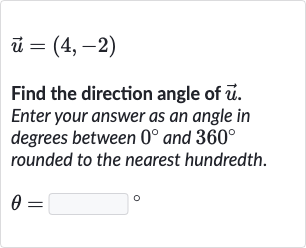Full solution
Q. Find the direction angle of . Enter your answer as an angle in degrees between and rounded to the nearest hundredth.
- Definition of direction angle: The direction angle of a vector in the coordinate plane is the angle the vector makes with the positive x-axis. To find this angle, we use the arctangent function (), which gives us the angle whose tangent is the ratio of the y-coordinate to the x-coordinate of the vector.Calculation: .
- Calculation of theta: Using a calculator to find the arctangent of , we get an initial angle. However, since the vector is in the fourth quadrant (because the -coordinate is positive and the -coordinate is negative), we need to add degrees to the initial angle if it's negative to ensure the angle is between and degrees.Calculation: Initial angle = degrees. Since it's negative, we add degrees to find the direction angle in the correct range.Theta = degrees.
More problems from Inverses of sin, cos, and tan: degrees
QuestionGet tutor help
QuestionGet tutor help
QuestionGet tutor help
QuestionGet tutor help
QuestionGet tutor help
QuestionGet tutor help
Question
. Find the value of in degrees.Write your answer in simplified, rationalized form. Do not round.____
Get tutor helpQuestionGet tutor help

